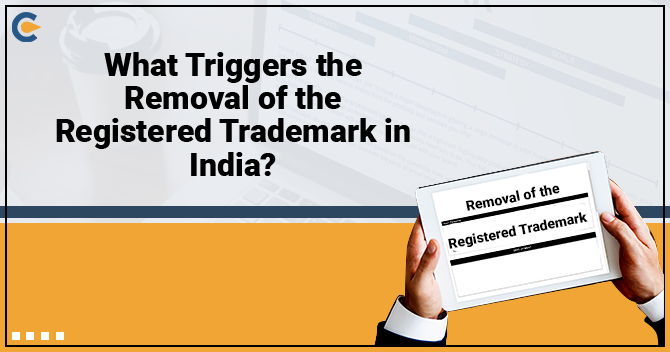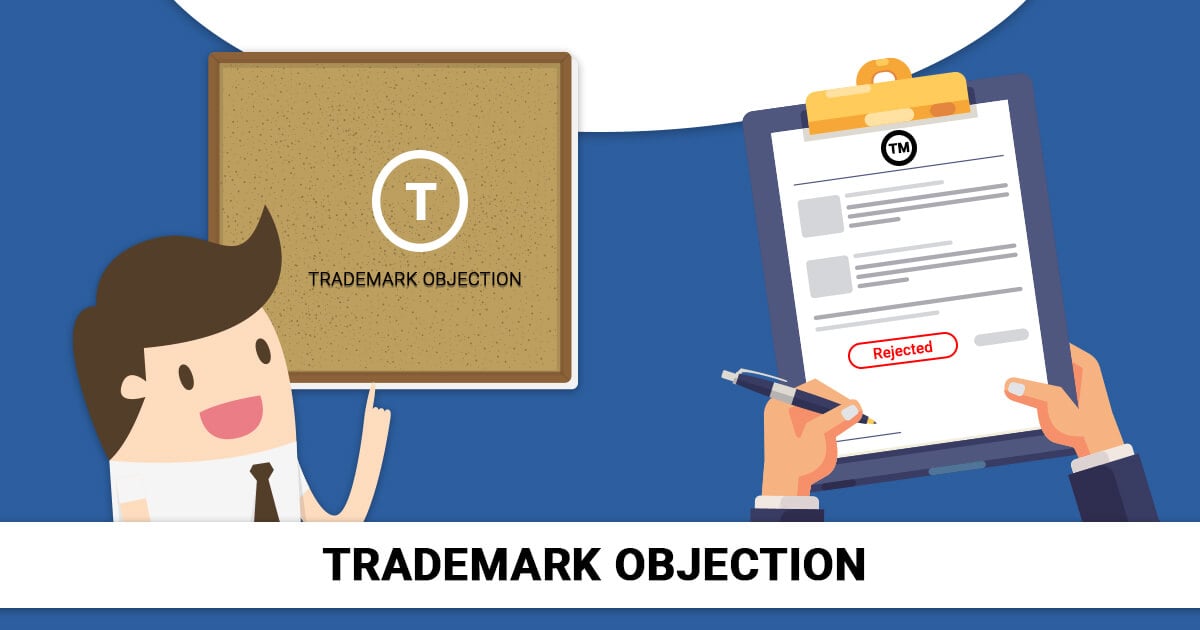In legal terms, the word trademark refers to a sign which has the ability to distinguish one’s product or services from another. We generally linked colours and symbols to a specific organization or product; hence it is vital for that product to safeguard its distinguishable identity from the rest who might intend to utilize this identity. In this article, let us understand about What Triggers the Removal of the Registered Trademark in India?.
What is the Trademark Registration?
A trademark registration aims to protect one’s IP rights, generally safeguards this distinguishable identity. Once a trademark becomes legally enforceable, it safeguards for ten years from the day it has been accorded.
After the completion of the said timeframe, the owner can continue to rejoice its benefits after renewing the same. There is a common misconception that a registered trademark cannot be opposed during its service life.
But, the Trademark Act of 1999 has some provisions in place that talks about the removal of the registered trademark under certain situations. A registered mark offers a service life of 10 years which can be extended for another ten years after renewal. The only exception to this is when the Registry gets rid of the trademark under particular scenarios.
It should be noted that any trademark owner can make a formal request to the authority for the removal of the registered trademark from the trademark registry. The prevailing trademark law entails the provisions for the removal of the registered trademark on the basis of certain grounds.
Read our article:Overall Trademark Registration in India
Who is an Aggrieved Person in the context of law?
Before we talk about the grounds, it is vital to ascertain who is an aggrieved person and who can make a request for the removal of the registered trademark?
In the case of Hardie Trading & Co. Ltd v Addison Paint & Chemical Ltd, the honourable court had construed who will be an aggrieved individual in the context of trademark removal.
The definition of an aggrieved person u/s 47 is further interpreted in the case of Cycle Corporation of Indian Ltd. v T I Raleigh Industries Pvt. Ltd, wherein the court had clarified that the “the expression “by any proprietor” cited in Section 47 should not be limited to the user by the registered user or proprietor who should also include bona fide. The legislature did not aim to deprive registered proprietors of their property at the instance of the user whose use is unregistered.
The expression, hence, should not be limited to the user by the proprietor or any registered user but should also consider bona fide authorized user”.
Therefore, we can conclude that an aggrieved person refers to an individual who is affected by the registration or someone whose application is still in process for the same mark. Or any individual who aims to discard the mark from the register to prevent the damage that it may cause.
It must be noted that law defies the concept of anonymous application filing, as the responsibility of proving the evidence lies on the shoulder of the applicant who is contending the trademark removal.
Legal Grounds that Triggers the cancellation/Removal of the Registered Trademark
There are plenty of reasons that could trigger the scenario of trademark removal. Some of them are mentioned below:


Falsification of facts
If there is adequate evidence to prove that the concerned mark was registered without any substantial cause or the user has availed the same via misrepresentation of facts to a preceding identical registered mark, then the Registry can remove the trademark from the register.
It so occurs that two trademarks get registered, but one mark has illicitly misinterpreted the fact of his/her mark during the registration processing. This implies the malicious intention of the applicant to get the mark registered, which is identical to that of an erstwhile registered mark. This leads to passing off, which is not allowable under that Act.
Therefore, those marks have to be discarded by the Registrar. This ground has been cited in Section 57(2) of the Act. It was decided that the falsifying facts during registration time are overlooked by the courts the case of Rhizome Distilleries Pvt. Ltd. v Union of India & Ors.
Making unfair modifications to the mark
The trademark should be removed if any modifications are incorporated to any registered mark & they do not comply with the rules of the Act. There are certain allowable alterations that can be made to a registered mark; however, modifications that alter the core nature of the mark are not permissible.
Change of work mark, logo & its colour scheme, change of the type of trademark, change in user date claimed, change in trademark class & change in the mark’s description shall not be allowed by the Registry.
If there is substantial proof in place that supports the aforesaid actions, then the Registrar can cancel the trademark.
Error committed by the Trademark Registry
Any default or error in any entry in the register or any entry falsely incorporated in the register shall lead to revocation of the trademark registration. Oftentimes default committed by the Registry can disrupt the owner’s goodwill and the onus of such an act is on the Registrar. Such scenarios could trigger the cancellation of the trademark registration.
Late renewal of the mark
The trademark must file an application for trademark renewal under form 12 before the Trademark Registry. Failure to renewal could compel the authority to remove the registered mark from the register. But it is vital to note that no mark can be subjected to removal without intimating the proprietor via written notification. Section 25(3) of the Trademark Act talks about the same. This provision specifies the Registry to prompt the trademark holder via notice before the time of protection is lapsed. Upon serving such a notice, if the authority fails to come across the renewal application and fees, the Registrar shall remove the mark.Failure in renewal could undermine the proprietor’s position and affect the licensees of the said trademark.
Non-adherence to Sec 9 & 11
It is vital for pending as well as a registered mark to stay in line with Sections 9 and 11 of the Act. Any non-compliance in this regard could compel the authority to expunge the mark. The removal of the registered trademark can also occur if the original prominence of the same is compromised.
Section 9 of the Trademark Act sets out the absolute grounds of refusal of registration & section 11 talks about the relative ground of refusal of registration.
Adherence to these grounds is vital for the obtainment of trademark registration. Furthermore, it is equally important to stay in line with these grounds in the post-registration phase.
Violation of Underlying Procedure
The authority has underpinned a definite procedure for filing, and complying with the same is an absolute necessity. Upon receiving the cancellation request, the Registrar shall intimate the registered proprietor to file this counter-statement against the one forward by the Registrar.
The said action must be taken in a stipulated time period, or else it would lead to the removal of the registered trademark.
Upon submitting the counter-statement, evidence in context to the same shall be conferred. Again this must be done in the specified timeframe. After facilitating the evidence, the Registrar may give the final judgement.
After the release of the judgement[1], the applicant can plead before IPAB within 90 days. Time is the key here; hence any delay in filing could amount to the cancellation of the trademark.
Non-utilization of the Registered Mark
Section 47 of the Act talks about the Trademark removal & imposition of the restrictions for not using the mark.
The said section sets out three fundamental grounds that could trigger the scenario of trademark removal.
Malicious intention
Trademark removal could come to effect if the Registry has enough proof to highlight the proprietor’s malicious intention. It is not uncommon to witness people filing marks in all 45 NICE classifications despite legal irrelevancy. Since such filing has no legal base, people often end up with one or two marks out of the 45.
In legal parlance, the non-utilization of the registered mark indirectly implies the monopolization of the proprietor over the word. Therefore, in this & other events, if it is proved that the trademark owner has no intention of using the mark w.r.t the products & services for which the mark has been filed, a cancellation applicant can be submitted for the trademark renewal, followed a procedure cited.
Non-use of the mark for five year
After coming across the evidence that indicates the non-utilization of the mark for the continual five years, the Registry can get rid of the mark. The five year period is computed from the date on which the mark finds its way to the register.
Please note that there are some exceptions to it that must be proved by the trademark owner, for instance, a limitation levied by the government or by ongoing law or provision that amounts to the non-use of the mark.
Three months use prior to application
As per the Trademark Act, the proprietor who seeks to register a certain mark is mandated to use it without illicit intention for at least three prior to the date of filing the registration application.
Legalities for Use & Non-Use of a mark
This section discusses the Use & Non-Use of a mark & it is vital to ascertain what it implies in the legal parlance. There is no way to determine if a trademark has been continually used or not; it depends on a case-wise basis.
Also, a question in that context arises: is it being utilized if it is just virtual & not real use?
Essentially the Trademark Act makes it simplified by elaborating the use, which shall be interpreted as a basis to the use of the trademark as printed or other visual manifestation, or in any physical or in any other connection whatsoever, to such services or goods.
Please note that the liability of proving the non-use lies on the individual filing the opposition, but the onus may shift on the mark owner during the legal proceeding. If he fails to establish his trademark’s usage, it shall be removed. Again, the cancellation/removal of the registered trademark primarily depends on the presentation of the case.
In the case of Pfizer Products Inc v Rajesh Chopra, the complainant has pleaded for injunction for passing off & prejudiced competition. The defendant had put up their case for the usage of mark: GORDON by the complainant. Both were claiming their ownership over the mark, and the accused claimed that the complainant’s non-use of the mark after registration should act as evidence for the cancellation of the said mark.
The court, however, rendered its judgement in favour of the complainants as they were operating worldwide, and it is vital to determine the mark’s gravity which is used in the trading of drugs; misconception, in this case, could lead to the significant loss.
In the case of Kabushiki Kaisha Toshiba v. TOSHIBA Appliances: the court said that the intention of the mark’s usage projected to the registered must be legitimate and practical. Moreover, when the mark comes under the legal regime, it accords a valuable right. It seeks to act as a source identifier for the concerned goods and services.
Hence, the individual who intends to use the mark with an illicit intention is less likely to get registered under trademark law. Section 47 of the Act mandates the bonafide utilization of the trademark during advertising or marketing campaigns or both.
Conclusion
Removal of the registered trademark in India mainly occurs due to infringement of the underlying provisions. Keep in mind that said law is quite strict when it comes to time-based compliances. So be watchful while dealing with the undertaking like renewing.
Read our article:How Can You Apply For Online Trademark Registration in India?











